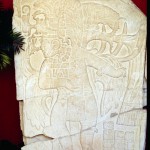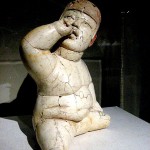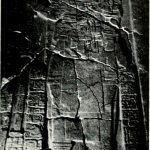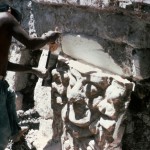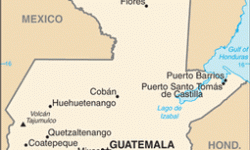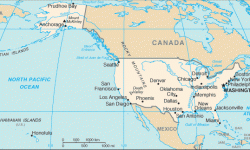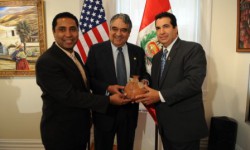Naranjo Stela 8
Author: Donna Yates
Last Modified: 10 Apr 2025
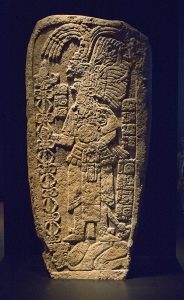
Maya sculpture trafficked to the USA, bought by a department store magnate, and physically returned to Guatemala in 2015.
Naranjo is a Maya site located near Guatemala’s border with Belize. It is 18 km north of the town of Melchor de Mencos via a logging road built in the 1950s (Peabody Museum n.d.). Naranjo was discovered in 1905 by Teobert Maler, who recorded 32 stela at the site, including Stela 8 (Maler 1908). The 1.87 meter tall stela 8 was the “easternmost of three stelae on the south side of Structure B-4” (Peabody Museum, n.d.).
The front of Stela 8 depicts a male ruler, Itzamnaaj K’awiil, in elaborate regalia standing on the back of a bound captive. The front inscription “enumerates 70 objects that [the ruler] lined up” which Prager notes were “probably 70 bundles and other objects that cannot be easily identified, which were presented to Itzamnaaj K’awiil in Naranjo” (Prager 2020). The back contains a hieroglyphic inscription.
Stela 8 was stolen “in about 1963” (Peabody Museum, n.d.). To make the stela easier to transport, the looters “broke it in two at the level of Glyph B5, after chipping the back away” (Peabody Museum, n.d.), effectively destroying the back to render the front more portable for sale. Coggins (1969: 96) recorded that the back was left in one large piece and several small ones.
The Stela 8 was trafficked to the USA where it was purchased by St. Louis, Missouri-based department store magnate Morton D. May (Reinhold, 1973). May reportedly purchased the Stela from Everett Rassiga (O’Neil 2022; See Placeres Stucco Temple Facade, La Amelia Stela 1, Las Bocas-Style Figurines). It was reported in the press that at some point the stela appeared in the May Company department store in Los Angeles for sale at the price of $55,000 (Reinhold, 1973). In 1966 May temporarily loaned Stela 8 to the St. Louis City Art Museum for display (Reinhold, 1973) where it was given inventory number 1966.564.
In a 1973 New York Times expose on monument theft in the Maya region, May is quoted as saying that when he learned that Stela 8 was stolen he removed it from display and attempted to return the piece to Guatemala. He claimed Guatemala had not responded to him by the time of publication (Reinhold, 1973). May did return ownership of Stela 8 to Guatemala but the piece itself stayed in St. Louis (O’Neil 2022).
When Stela 8 was redisplayed in St. Louis City Art Museum in 2013 it was listed as “Lent by the National Museum of Archaeology and Ethnology, Guatemala, under the authority of the Ministry of Culture and Sport” and the display was billed as temporary (Robb and Clark 2013: 74). Stela 8 has since been returned to Guatemala.
[IMAGE: The front of Naranjo Stela 8 photographed in 2019 in the Royal British Columbia Museum, by “Ymblanter” via Wikimedia Commons]
WORKS CITED
O’Neil, Megan E. (2022) The Maya: Lost Civilizations. Reaktion Books.
Peabody Museum of Archaeology & Ethnology (n.d.) Naranjo. Corpus of Maya Hieroglyphic Inscriptions. https://peabody.harvard.edu/naranjo. Accessed on 6 August 2023.
Prager, Christian M. (2020) The Sign 576 as a Logograph for KUK, a Type of Bundle. Research Note 15. Textdatenbank un Wörterbuch des Klassischen Maya. DOI: 10.20376/IDIOM‐23665556.20.rn015.en
Reinhold, Robert (1973) Scholars of Maya in a Race with Art Thieves and Time. 26 March. https://www.nytimes.com/1973/03/26/archives/article-2-no-title-scholars-of-maya-in-a-race-with-art-thieves-and.html. Accessed on 6 August 2023.
Robb, Matthew H. and Amy Clark (2013) The ancient American installation at the Saint Louis Art Museum. Tribal art (69): 74-81

